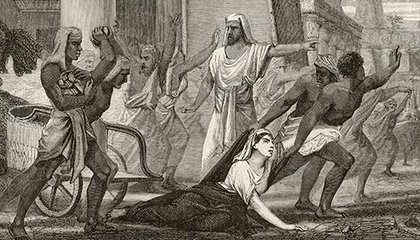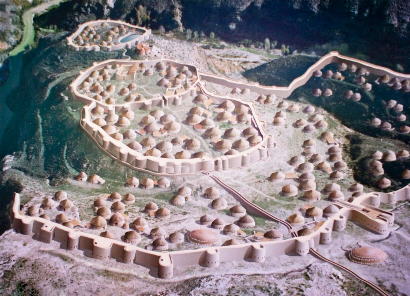Literacy (Indus glyphs) exists throughout the Indus Valley civilization.
State of Harappa and Rupar  Civilized Bronzeworking Centralized Monarchy
Civilized Bronzeworking Centralized Monarchy
Abhinabyu, King of Harappa
Abhinabyu - having proven himself incapable of (and having no interest in) administering the
kingdom, stood ready to react to invasion. To increase his forces another 400 men were trained to
the bow and 200 in skirmishing and scouting. While the king spent much of his time with the army,
he did enjoy his wife Priya, siring daughters in 2070, 2069 and 2068.
Prince Ritpara and lieutenant Zeeshan administered the dual state. More scribes were hired to help
run the bureaucracy. A communal dining hall and another dormitory were built at the expanding
University. In Harappa a new central plaza was begun including public fountains and rows of shade
trees, with a public library to be at one end and an amphitheater at the other. Nor was the
countryside neglected: in Sahis more irrigation from the Saraswati
resulted in more productive fields and pastures, and in Und laborers took the first steps toward
clearing the remaining wilderness.
In late spring 2067 tragedy struck. A group of royal ladies went to shop and view the new plaza
under construction. As they passed what would become the new library a section of
scaffolding collapsed into the street in an avalanche of wood, mud brick, mortar and screaming
workmen. Crushed under the mass was queen Priya, Fulmala (widow of the previous king) and Rewati
(daughter of another king). Many of the twenty-something royal women suffered varying degrees
of injury.
A month of mourning was ordered in the kingdom. At its conclusion King Abhinabyu - ever the
practical monarch - chose a bride from among the local noblewomen. Surprisingly, many were eager
to become Queen despite the high turnover rate in the job. In late 2066 his latest
wife produced another daughter.
Traders of Dholavira  Seafaring Bronzeworking Oligarchy
Seafaring Bronzeworking Oligarchy
Polyar, First of the Council
Polyar led the Council debate regarding finances resulting in small amounts invested in
military quality and enticing people to work for the government in various capacities. The
University was funded to build a small library. In the distant port of Qana groves of shade
trees were planted, more water lines and public fountains installed (it gets hot there!) and
the rundown waterfront area rebuilt.
Polyar then held court - despite the increasing frequency of dizzy spells - and spent time with
his wife Imasha, the daughter of the previous First and sister of Harshan, current Sword of the Council.
In summer 2066 students at the University began protesting standards of admission and
graduation, quality of lodging and food, corruption in the administration, government control
of finances ... in short pretty much everything. Instead of attending classes students spent
their time in "rallies" where they got drunk and hailed speakers who complained and demanded increasingly radical changes. Most teaching Scholars (ie professors) had fled but those with
delusional utopian views remained and sided with the protesters.
In failing health and judgement Polyar decided to go to the University. Imasha insisted in
accompanying him. Although concilatory he was shouted down by the increasingly emboldened
students; when his guards drew swords and moved to escort him to safety a youth cried out the
crowd was in danger and threw a paving stone. The mob copied the act; badly outnumbered the guards
were hit repeatedly. A stone hit the First in the face sending him to his knees; he suddenly
clutched his chest and collapsed. His wife screamed but was beaten down as the protest became
a full-scale riot as students used rocks or fists against anyone not one of them.

Rioters kill Imasha while a radical Scholar urges the mob onward
Second of the Council
Harshan kept his squadron of pentaconters busy patrolling the waters around Dholavira lest a
neighbor attempt a landing. A small galley met them with news of the riot. Angry beyond words
Harshan ordered his ships to dock and returned to the city and took command of the city
garrison. A terrified Council voted him the new First. He in turn urged Polyar's son (and
his nephew) Harvan, a recent member of the Council, be appointed the new Second.
Realizing they'd crossed a line and there was no turning back, radical students and Scholars
barricaded the University campus after looting adjacent neighborhoods. Hundreds of
students armed themselves with makeshift weapons and vowed to resist any attempt by the Council
to retake the campus. They demanded half of Dholavira's budget be spent on the University and
amnesty for everyone involved.
A tense standoff ensued while the Council debated what to do.
City-State of Lothal  Seafaring Bronzeworking Monarchy
Seafaring Bronzeworking Monarchy
Cherasan, King of Lothal
Cherasan suddenly realized his cities lacked defensive walls and ordered such built immediately.
Another stone fort was constructed in the homeland as well. The king heavily funded naval architects who promised to deliver new ship designs and prototypes.
Alas, they fell to arguing and ultimately accomplished nothing. Lothal had additional water and
sewer pipes installed, public housing built for the poor, more streets paved and a public park with
shade trees and ponds landscaped.
Cherasan thereafter held court with 11-year-old son Ervam at his side learning the art of ruling.
In 2069 a
feverish sickness1 swept the palace - perhaps brought by a trader or visitor from another land - and the boy was among mostly children or elderly who perished. The king grieved but
inexplicably continued to ignore his Nasiki wife Chee who was the boy's mother.
Heir David remained in Lothal as well, helping the king administer the nation but likewise ignoring
his wife Drusa, also from Nasiki. The wives spent much time together out of the palace - it was
rumored frequenting brothels that catered to women. Who could blame them?
In summer 2067 while playing with her siblings in the water near the harbor Cherasan's 10-year-old daughter Emeen screamed and started thrashing. The venom of the banded sea krait is highly toxic
and stronger than any land snake in the area. She was dead within the hour.
Meanwhile ten pentaconters commanded by lieutenant
Devi set out south along the coast. In late 2066 they returned intact
and docked at Lothal, the crews rushing en masse to dockside bars and fleshpots. Devi reported
to Cherasan in a triumphant mood.
1 sore throat, cough, congestion, high fever, aches everywhere - the flu and nary a
flu shot to be found.
